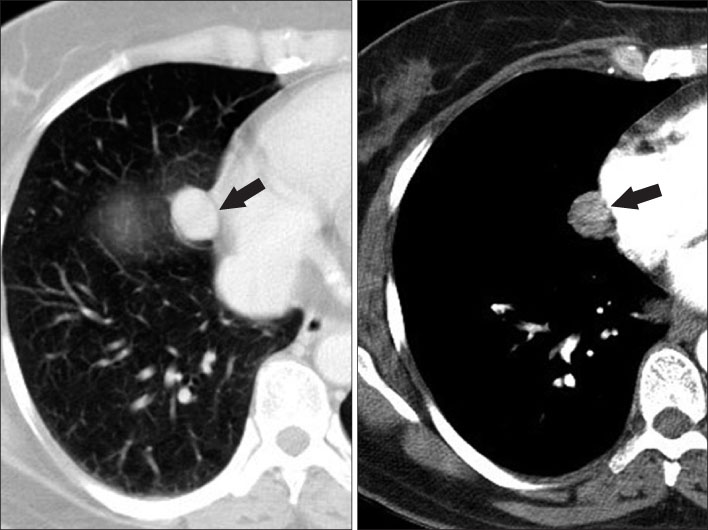Tuberc Respir Dis.
2010 Sep;69(3):191-195.
Supradiaphragmatic Heterotopic Liver Presenting as a Pleural Mass: A Case Report
- Affiliations
-
- 1Department of Pathology, Gachon University Gil Hospital, Incheon, Korea.
- 2Department of Pathology, Samsung Medical Center, Sungkyunkwan University School of Medicine, Seoul, Korea. hanjho@skku.edu
- 3Department of Radiology, Samsung Medical Center, Sungkyunkwan University School of Medicine, Seoul, Korea.
- 4Department of Thoracic Surgery, Samsung Medical Center, Sungkyunkwan University School of Medicine, Seoul, Korea.
Abstract
- Abnormally located liver tissue has been described in the vicinity of the liver proper, near anatomical structures such as the gallbladder, the umbilical fossa, the adrenal gland, the pancreas, and the spleen. Supradiaphragmatic ectopic liver is a rare finding, but has been reported to have been found in the intrathoracic cavity and in the pericardium. In the majority of supradiaphragmatic ectopic liver cases, there was an accompanying transdiaphragmatic pedicle of the main liver body into the abdominal cavity. In a minority of supradiaphramatic ectopic liver cases, the liver was completely separated from the abdominal cavity without a connection between the thorax and the abdomen, with accompanying diaphragmatic anomalies. We describe one case of intrathoracic ectopic liver in a patient with a previous history of lower chest wall trauma, and a brief review of the English-language medical literature on this topic.
MeSH Terms
Figure
Reference
-
1. Lasser A, Wilson GL. Ectopic liver tissue mass in the thoracic cavity. Cancer. 1975. 36:1823–1826.2. Mendoza A, Voland J, Wolf P, Benirschke K. Supradiaphragmatic liver in the lung. Arch Pathol Lab Med. 1986. 110:1085–1086.3. Hansbrough ET, Lipin RJ. Intrathoracic accessory lobe of the liver. Ann Surg. 1957. 145:564–567.4. Le Roux BT. Heterotopic mediastinal thyroid. Thorax. 1961. 16:192–196.5. Sehdeva JS, Logan WD Jr. Heterotopic (supradiaphragmatic) liver. Ann Thorac Surg. 1971. 11:468–471.6. Rendina EA, Venuta F, Pescarmona EO, Martelli M, Ricci C. Intrathoracic lobe of the liver: case report and review of the literature. Eur J Cardiothorac Surg. 1989. 3:75–78.7. Shapiro JL, Metlay LA. Heterotopic supradiaphragmatic liver formation in association with congenital cardiac anomalies. Arch Pathol Lab Med. 1991. 115:238–240.8. Kinnunen P, Kulmala P, Kaarteenaho-Wiik R, Vuopala K. Ectopic liver in the human pericardium. Histopathology. 1997. 30:277–279.9. Iber T, Rintala R. Intrapulmonary ectopic liver. J Pediatr Surg. 1999. 34:1425–1426.10. Babu R, Van der Avoirt A. Ectopic intrathoracic liver. Pediatr Surg Int. 2001. 17:461–462.11. Luoma R, Raboei E. Supradiaphragmatic accessory liver: a rare cause of respiratory distress in a neonate. J Pediatr Surg. 2003. 38:1413–1414.12. Huang CS, Hsu WH, Hsia CY. Supradiaphragmatic ectopic liver: delayed traumatic hepatic hernia mimics pulmonary tumor. Thorac Cardiovasc Surg. 2007. 55:277–278.13. Choi SU, Kim HK, Kim J. Heterotopic supradiaphragmatic liver combined with intralobar pulmonary sequestration. Ann Thorac Surg. 2008. 85:1809–1810.14. Hudson TR, Brown HN. Ectopic (supradiaphragmatic) liver. J Thorac Cardiovasc Surg. 1962. 43:552–555.15. Collan Y, Hakkiluoto A, Hästbacka J. Ectopic liver. Ann Chir Gynaecol. 1978. 67:27–29.
- Full Text Links
- Actions
-
Cited
- CITED
-
- Close
- Share
- Similar articles
-
- Supradiaphragmatic Liver Confirmed by a Hepatocyte-specific Contrast Agent (Gd-EOB-DTPA): A Case Report
- A Case of a Huge Mass Due to Pleural Metastasis and Management of Dyspnea in a Patient with Terminal Breast Cancer
- Intraabdominal Heterotopic Thymus: Report of an autopsy case
- Cystic Degeneration of Uterine Fibroid Mimicking Heterotopic Pregnancy with In terstitial Pregnancy: A Case Report
- Hairy cell leukemia presenting as a pleural mass without leukemic component: a case report



